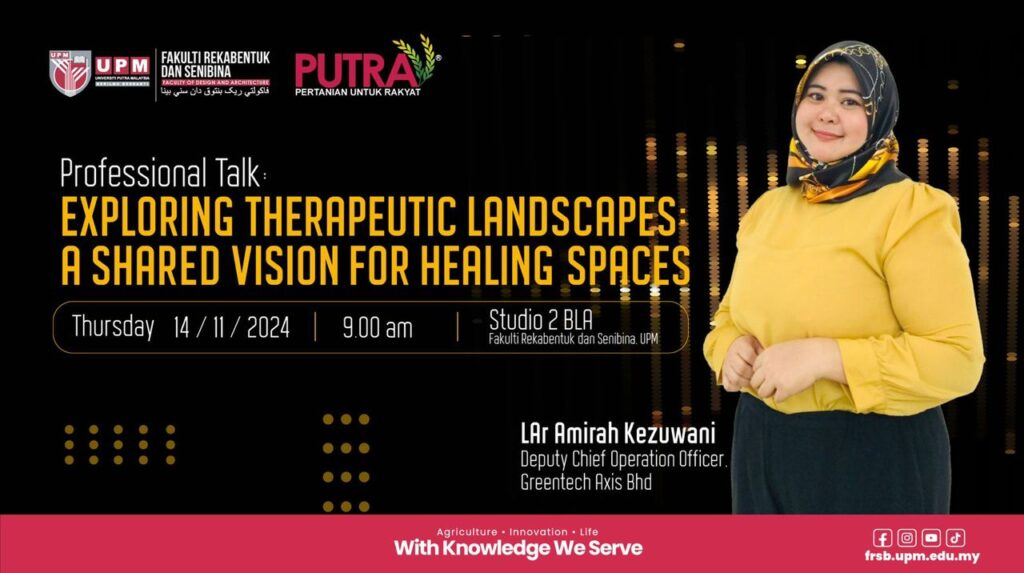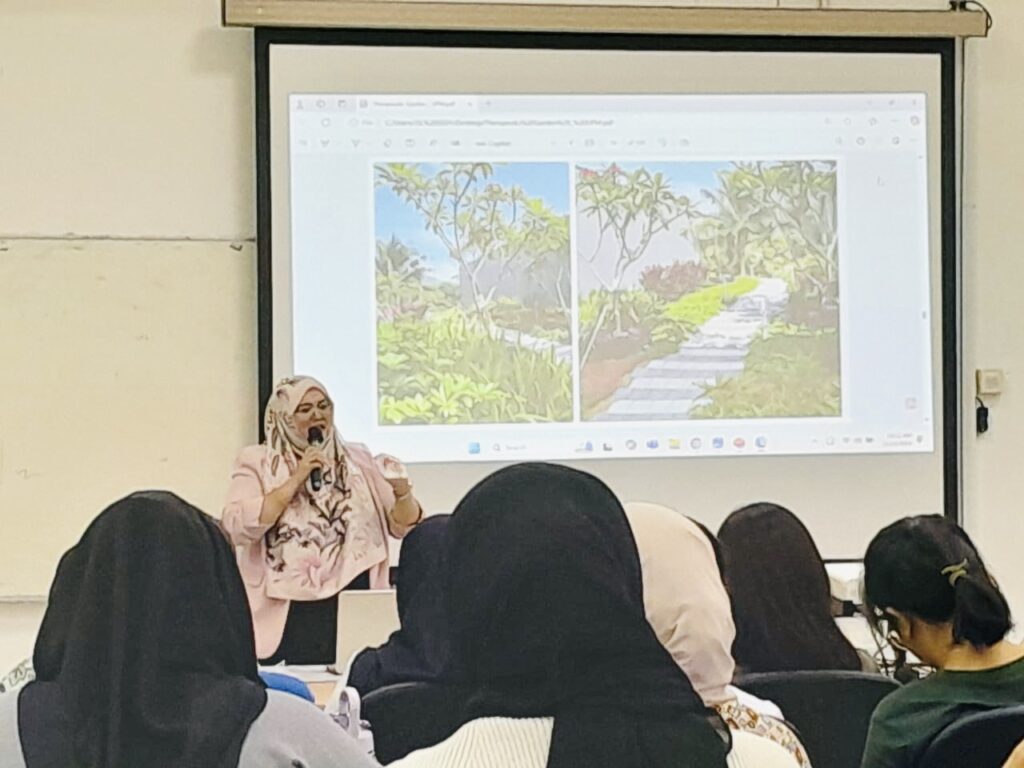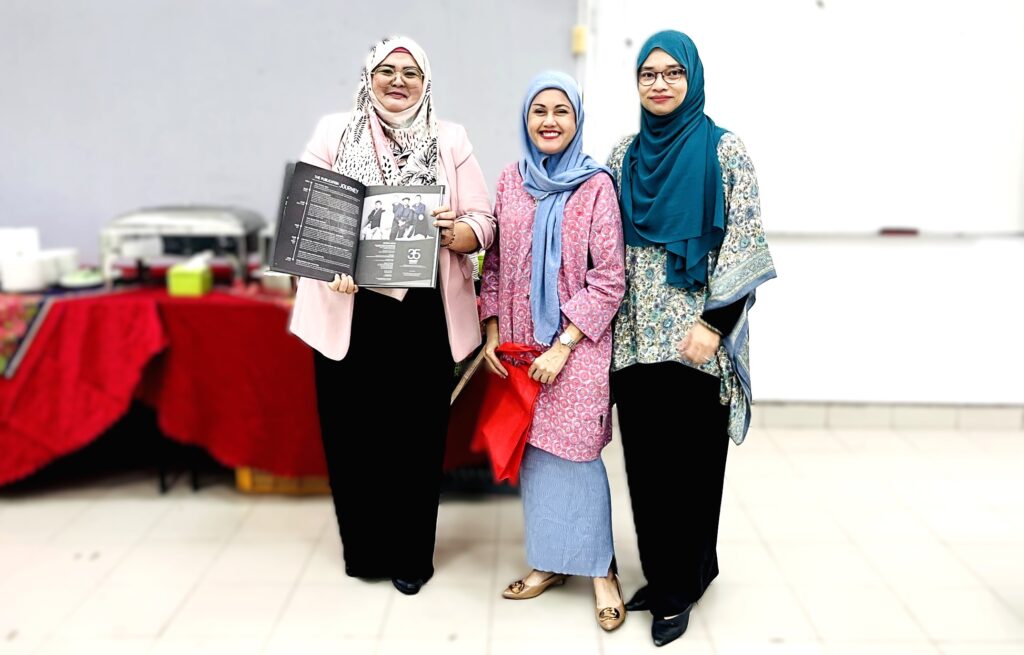

Date: 14 November 2024
Venue: Universiti Putra Malaysia (UPM), Faculty of Design and Architecture
As part of an ongoing initiative to foster knowledge exchange and inspire the next generation of landscape architects,a knowledge-sharing session was held with students from Universiti Putra Malaysia’s Landscape Architecture program. This interactive event focused on the design, implementation, and impact of therapeutic gardens, emphasizing their relevance and potential in Malaysia.
The session speaker by LAr. Ts. Amirah Kezuwani, Director of RIMBAA REKA Resources, delved into the concepts, design principles, and impact of therapeutic gardens, particularly in the Malaysian context. This session is hosted by LAr. Dr. Roziya Ibrahim.
HIGHLIGHTS FROM THE SESSION
Insights from LAr. Ts. Amirah Kezuwani

Introduction to Therapeutic Gardens
Therapeutic gardens, a growing trend in landscape architecture, are spaces designed to promote physical, mental, and emotional well-being. In Malaysia, the integration of such gardens reflects a unique blend of cultural, ecological, and functional considerations. This article explores the core design principles and user-centric features that define therapeutic gardens, with a focus on their relevance and application in Malaysia.
The session began with an overview of therapeutic gardens, highlighting their definition, purpose, and application in various contexts, such as hospitals, rehabilitation centers, and public spaces and shared insights into the role of these gardens in promoting physical, mental, and emotional well-being.
Exploration of Design Principles
User-Centric Features / User-Focused Accessibility
Therapeutic gardens prioritize inclusivity by ensuring barrier-free access for all. Features like ramps, wide pathways, and seating at various heights cater to individuals with mobility challenges. In Malaysia, these considerations are critical for serving the elderly, people with disabilities, and patients in recovery.
Emphasizing accessibility, safety, and sensory engagement, therapeutic gardens are tailored to various demographics, including patients in recovery, individuals with sensory processing disorders, and those seeking stress relief.
Cultural and Climatic Adaptation
Therapeutic gardens are outdoor spaces designed to enhance physical, psychological, and social well-being. In Malaysia, these gardens must not only embrace universal principles of healing landscapes but also adapt to the unique cultural and climatic contexts of the region.
Cultural Adaptation
Malaysia’s cultural diversity plays a significant role in shaping therapeutic garden designs. The following aspects are essential:
- Reflecting Multicultural Heritage : A therapeutic garden in Malaysia can incorporate elements from Malay, Chinese, Indian, and Indigenous cultures. Traditional Malay gardens, with their emphasis on shade, water features, and medicinal plants, offer a foundation. Combining these with Chinese feng shui principles or Indian courtyard designs creates a culturally harmonious space.
- Incorporating Traditional Practices : Incorporating plants and herbs used in traditional remedies, such as tongkat ali, kacip fatimah, and lemongrass, adds layers of cultural relevance. Spaces for yoga, tai chi, or silat practice provide opportunities to connect with cultural health practices.
- Rituals and Spirituality : Malaysia’s religious diversity offers opportunities for reflection spaces. For example, prayer nooks or meditative pathways aligned with Islamic, Buddhist, or Hindu traditions could be included to cater to spiritual well-being.
Climatic Adaptation
Malaysia’s tropical climate, characterized by high temperatures, humidity, and frequent rainfall, necessitates unique design strategies:
- Shade and Cooling Elements : Using trees like Rain Tree (Samanea saman), Frangipani (Plumeria spp.), and Bamboo provides natural shade. Pergolas, shaded walkways, and water features contribute to a cooling effect, essential for comfort in the humid climate.
- Stormwater Management : Rain gardens, bioswales, and permeable paving are critical to handling Malaysia’s frequent and heavy rainfall. These features not only prevent flooding but also contribute to the garden’s biodiversity.
- Plant Selection : Choosing hardy, low-maintenance, and native plants such as Hibiscus (Hibiscus rosa-sinensis), Heliconia, and Ferns ensures resilience to the tropical climate. These plants also attract local fauna, fostering a connection to the ecosystem.
Universal Design with Local Adaptations
Therapeutic gardens must remain accessible and inclusive. This is achieved through:
- Accessible Pathways: Anti-slip surfaces suitable for wet weather.
- Seating and Rest Areas: Placed under shaded areas with materials resistant to tropical conditions.
- Sensory Elements: Aromatic plants like jasmine and lemongrass engage the senses, while water features offer auditory relaxation.
Therapeutic gardens in Malaysia exemplify a synergy between cultural identity and ecological adaptation. By integrating local heritage and sustainable practices, these gardens not only promote healing but also foster a deeper connection to nature and culture in a tropical setting.
Multisensory Engagement
To stimulate the senses, therapeutic gardens incorporate elements such as fragrant flowers, textured surfaces, calming water features, and vibrant colors. For instance, the sound of trickling water or the scent of jasmine provides sensory stimulation while promoting relaxation.
Safety and Comfort
Safety is paramount in therapeutic gardens. Non-slip surfaces, shaded seating areas, and clear wayfinding signage ensure user safety and comfort. In Malaysia’s tropical climate, providing adequate shade and ventilation is essential to ensure the gardens remain usable throughout the day.
Ecological Integration
Malaysian therapeutic gardens often integrate sustainable practices, such as rainwater harvesting and native landscaping, to align with the nation’s ecological goals. The use of low-maintenance plants also reduces operational costs and supports local biodiversity.
Design Principles and Challenges
The session emphasized the importance of user-centric design, biophilic elements, and climate adaptability. Participants were introduced to the principles of universal design to ensure accessibility for all, including pathways for wheelchairs and features catering to different demographics.
- User-Centric Design: A core principle in creating therapeutic gardens is designing spaces that cater to the needs and experiences of all users, ensuring they can interact with nature in a meaningful and restorative way.
- Biophilic Elements: Incorporating elements of nature that enhance human well-being, such as plants, water features, and natural materials, is crucial. These elements contribute to stress reduction and promote mental and physical health.
- Climate Adaptability: Given Malaysia’s tropical climate, the design must consider the region’s weather patterns, including high humidity and rainfall. The selection of plant species and materials that can withstand these conditions is essential.
- Universal Design: Ensuring accessibility for all users, including those with mobility issues or special needs, is vital. This includes designing pathways that accommodate wheelchairs, seating arrangements that are comfortable for different users, and features that consider the needs of diverse age groups and abilities.
Challenges such as space limitations, maintenance, and integration with existing infrastructure were also discussed.
- Space Limitations: In urban areas like Malaysia’s cities, space is often a constraint, making it challenging to create large therapeutic gardens. Designing compact yet effective spaces that still provide a calming environment is a significant challenge.
- Maintenance: The tropical climate poses challenges for maintenance, as plants and features must be carefully managed to avoid overgrowth, pest issues, and damage from heavy rainfall or humidity.
- Integration with Existing Infrastructure: Incorporating therapeutic gardens into existing landscapes, particularly in urban settings, requires careful planning to ensure the design integrates seamlessly with surrounding structures, traffic flow, and other amenities.
Future Trends in Therapeutic Gardens
The session concluded with a discussion on emerging trends, such as integrating forest bathing (Shinrin-yoku) and grounding practices into therapeutic landscapes. Ideas like reflexology paths, nature-based art therapy, and wildlife therapy gardens were explored as innovative ways to enhance user engagement and well-being.
Contributions Expert Insights from Assoc. Prof. Dr. Shureen Faris Abdul Shukor
(PhD in Restorative Green Outdoor Environment For Healthcare Facilities, University of Copenhagen)

Understanding Therapeutic Gardens
Associate Professor Dr. Shureen Faris Abdul Shukor, a specialist in restorative green environments, elaborated on distinguishing between therapeutic gardens and healing gardens. She stressed that therapeutic gardens are ideal for healthcare settings, while healing gardens have broader applications in public and commercial spaces.
Therapeutic Gardens
- Purpose: Specifically designed to cater to the therapeutic needs of individuals, often integrating elements that support physical, mental, or emotional rehabilitation.
- Settings: Typically located in healthcare facilities, such as hospitals, rehabilitation centers, or nursing homes.
- Design Focus: Prioritizes user-specific needs, often including accessibility features, sensory stimulation, and areas for physical therapy activities.
Healing Gardens
- Purpose: Broader in scope, these gardens aim to promote general well-being and stress relief without necessarily addressing specific therapeutic goals.
- Settings: Found in public spaces, commercial environments, or residential areas, such as parks, office complexes, and community centers.
- Design Focus: Encourages relaxation and connection with nature, often featuring soothing aesthetics, water elements, and diverse plantings.
The Interdisciplinary Design and Planning of Therapeutic Gardens
The design and planning of therapeutic gardens are highly interdisciplinary, requiring collaboration between landscape architects and other professionals, including doctors, psychiatrists, nurses, and therapists. This ensures that the gardens are thoughtfully designed to address the physical, psychological, and emotional needs of users. For landscape architects, integrating these elements while collaborating with healthcare professionals ensures the therapeutic garden fulfills its purpose: promoting healing and well-being in a supportive environment.
“Therapeutic gardens design exemplify the synergy of interdisciplinary collaboration, combining the expertise of landscape architects with healthcare professionals such as doctors, psychiatrists, nurses, and therapists. This cooperative approach ensures the design thoughtfully addresses users’ physical, psychological, and emotional needs.”
For landscape architects, the challenge lies in harmonizing aesthetic and functional design with the specific therapeutic goals defined by healthcare experts. By incorporating features that promote relaxation, physical activity, and sensory stimulation, these gardens become healing spaces that support well-being. Ultimately, therapeutic gardens are a testament to the power of integrated planning, offering environments that nurture recovery and foster holistic health for their users.
Reflexology Path Design Safety
Dr. Shureen shared insights on incorporating reflexology paths and the importance of consulting healthcare professionals to ensure safety. Her expertise in restorative green environments added depth to the discussions.
https://www.takingcharge.csh.umn.edu/are-there-times-when-i-shouldnt-have-reflexology
Inspiring Future Landscape Architects

Therapeutic gardens hold the potential to inspire the next generation of landscape architects by showcasing how design can blend aesthetic, functional, and healing elements. The session emphasized their versatility and positive impact on users by featuring projects tailored for various environments:
- Healthcare Facilities: Examples of therapeutic gardens in hospitals were presented, demonstrating how these spaces reduce stress and promote healing for patients, families, and healthcare workers.
- Urban Centers: The integration of green oases within bustling cities provides stress relief and mental rejuvenation for urban dwellers, illustrating the importance of biophilic design.
- Residential Areas: Community gardens and private therapeutic spaces were highlighted as ways to improve the quality of life for residents, fostering social interactions and well-being.
Special focus was given to sensory gardens designed for the elderly, catering to their physical, sensory, and emotional needs, and rehabilitation gardens with features like accessible paths, exercise stations, and calming green spaces for recovery and mobility training.
By designing for inclusivity and sustainability, the session inspired participants to view landscape architecture as a tool for creating user-focused, healing environments that align with Malaysia’s broader goals for sustainable development and livable communities. This approach encourages future landscape architects to innovate and prioritize human well-being in their designs.
Impact of the Sharing Session
We hope this session inspires soon to be Young Landscape Architects to consider therapeutic garden design in their future projects. The session highlighted how therapeutic gardens can address Malaysia’s urbanization challenges while fostering community well-being and sustainability.
This collaboration marks a step forward in equipping young designers with the knowledge and skills to create meaningful, healing spaces across Malaysia.
A special thanks to Dr. Aini Jasmin Binti Ghazalli for her invaluable support and for providing the opportunities and invitations that made these sessions possible.